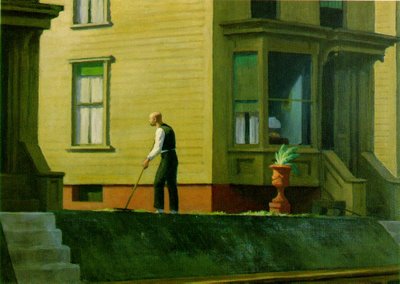ART GALLERY - Edward Hopper

Edward Hopper (American, 1882–1967), the best-known American realist of the inter-war period and one of my favourits. Pennsylvania Coal Town, 1947. Oil on canvas, 28 x 40".
While his watercolors were always painted on location, Hopper's mature oils were often imagined scenes based on various places. Hopper finished his canvas Pennsylvania Coal Town in his New York studio on April 23, 1947. This picture depicts the figure of a bald man raking leaves by the side of a nondescript house. The scene is the closest Hopper ever came to expressing sympathy with the masses.
Pennsylvania Coal Town brings to mind Sherwood Anderson's 1917 novel Marching Men, set in the Pennsylvania coal region in a town called Coal Creek. The novel, which Anderson dedicated "To American Workingmen," comments on the oppressiveroutine of workers' lives. Anderson described the town as "hideous ... a necessity of modern life."
Hopper's painting of the man with the rake recalls Anderson's description: 'An Italian who lived in a house on a hillside cultivated a garden. His place was the one beauty spot in the valley... When a strike came on he was told by the mine manager to go on back to work or move out of his house. He thought of the garden and of the work he had done and went back to his routine of work in the mine. While he worked the miners marched up the hill and destroyed the garden. The next day the Italian also joined the striking miners." In fact, Hopper suggests the "Italian' ethnicity of the man with the rake by including an unexpectedly elegant object at the front of the otherwise dreary house: a classical terra cotta urn on a stand, an Italianate garden ornament illuminated by the same sunlight that shines on the man's bald head.
Labels: Edward Hopper

0 Comments:
Post a Comment
<< Home